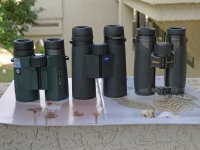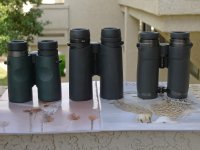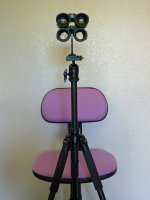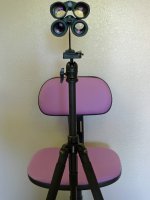Conclusions and recommendations:
First off, I have to say that I am exceptionally disappointed in the fit and finish of my Zeiss Conquest HD compared to its two rivals. I have read that some people have had problems with their eyecups. Fortunately I haven’t had any hassles with mine, but they do feel very gritty turning them up and down. Setting them in and out about 30 to 40 times did ease the grittiness some, but still didn’t eliminate it. Secondly, I’m not crazy about the way they implemented the lock system for the different settings. The Pentax and the Nikon move smoothly and click smoothly into place for the different settings. The Zeiss seems to have a system of two closely spaced bumps (or two indentations) so that the eyecup has to first click over the first bump before it's locked and held in place by the second. Coupled with the gritty feeling lends a low quality feel to it.
Finally, the focus tension on the focusing ring and diopter, which doesn't lock into place, is not only as tight as the Pentax, it’s also very jerky and uneven due to excessive “sticktion”. FWIW there was a lot less sticktion on the diopter ring. IMHO the tension of the Pentax is a little excessive, but I can live with it because it’s very smooth, feels the same in both directions and starts and stops with zero sticktion or backlash. The excessive sticktion on the Zeiss requires much more effort to start it moving, and when it does, it jerks along, stopping and starting, thereby making critical focusing very difficult and time consuming. Notwithstanding their other outstanding attributes, these binos were not a joy to use, but a major pain because of this major defect. Hopefully this bad sample is a one off and not indicative of the others. The bottom line for me is that I’ll be returning these ASAP.
The fit and finish on the Nikon Edg exudes Rolls Royce quality and workmanship. These binos aren’t cheap and the build quality is commensurate with the price. Focus is oil slick smooth with zero free play or backlash. Everything about them shows a well thought out and executed design, notwithstanding their small design flaw concerning the diopter which only became apparent for many after much use. A flaw that they acknowledged and most generously corrected.
Fit and finish of the Pentax ED is also exceptionally good IMHO. Not close to the Nikon’s Rolls Royce quality, but solid, firm, smooth and everything works exactly the way it should.
For those who demand the best, the Nikon Edg is an easy, confident but expensive recommendation. After all this switching back and forth among these contenders I still highly recommend the Pentax ED for its outstanding value for money, its solid build quality, the outstandingly sharp high resolution and low CA and low distortion view that it offers, coupled with its exceptionally generous “No Fault Lifetime” warranty.
I cannot in good faith recommend the Zeiss until these teething problems with this new design have been sorted out. If you are one of those who is very sensitive to CA, then even with all those faults taken care of, these binos are probably not for you. Under most normal conditions of use I didn’t find the CA excessive or intrusive, but I must admit that for this kind of money I had expected better from Zeiss in that regard. In all other respects optically they exceeded my expectations and hope they can sort out these minor defects quickly.
Now if nobody minds, I’m going to kick off my shoes (and loupes) and relax with a nice cold one B








